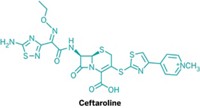Advertisement
Grab your lab coat. Let's get started
Welcome!
Welcome!
Create an account below to get 6 C&EN articles per month, receive newsletters and more - all free.
It seems this is your first time logging in online. Please enter the following information to continue.
As an ACS member you automatically get access to this site. All we need is few more details to create your reading experience.
Not you? Sign in with a different account.
Not you? Sign in with a different account.
ERROR 1
ERROR 1
ERROR 2
ERROR 2
ERROR 2
ERROR 2
ERROR 2
Password and Confirm password must match.
If you have an ACS member number, please enter it here so we can link this account to your membership. (optional)
ERROR 2
ACS values your privacy. By submitting your information, you are gaining access to C&EN and subscribing to our weekly newsletter. We use the information you provide to make your reading experience better, and we will never sell your data to third party members.
Environment
Putrid Pathway Probed
Natural Products: Studies of odorant biosynthesis could aid water remediation
by Stu Borman
April 5, 2012

Structural and mechanistic analyses have revealed how two bacterial enzymes biosynthesize the terpenoid odorant 2-methylisoborneol (MIB) (Biochemistry, DOI: 10.1021/bi300109c and 10.1021/bi201827a). The work could lead to an improved understanding of factors promoting MIB production and ways to mitigate MIB odors and off-flavors in food, beverages, and the water supply.
MIB is a volatile terpenoid produced by microorganisms. Its musty odor can be detected at low concentrations, in the parts-per-trillion range. It contributes to the scent of moist soil and Brie and Camembert cheeses. But its odor can also taint fish and cause off-taste and odor in drinking water.
“We expect that the structures of the enzymes responsible for MIB biosynthesis will lead to new approaches for inhibiting the generation of this contaminant, which threatens the public water supply and causes multimillion-dollar annual losses in the food and beverage industry,” says chemistry professor David W. Christianson of the University of Pennsylvania. He carried out the work with Penn postdoc Mustafa Köksal and chemistry professor David E. Cane and postdoc Wayne K. W. Chou of Brown University.
The structures show that one enzyme, geranyl diphosphate methyltransferase (GPPMT), is a hexamer resembling a Star of David, and that the other, MIB synthase (MIBS), is a fan-shaped homodimer of two 13-α-helix bundles.
Scientists already knew that GPPMT methylates a 10-carbon monoterpene substrate and that MIBS then cyclizes the product to MIB. In all other terpenoid biosyntheses, methylation occurs only after cyclization, not before. The new studies have uncovered further details about the mechanism of this unique biosynthetic process.
MIB is currently removed during water treatment by activated carbon filtration; biological filtration with immobilized bacteria; or UV, ozone, or hydrogen peroxide-based oxidation. But MIB contamination is difficult and expensive to remedy by such means, and water utilities are seeking better methods.
Christianson believes the new studies could aid rational design of GPPMT or MIBS inhibitors that might mitigate MIB generation in water sources. Research scientist Sue Watson of the National Water Research Institute, Burlington, Canada, believes jurisdictions are unlikely to permit treatment of water with enzyme inhibitors. However, she adds, the studies aid understanding of factors controlling expression of genes for the two enzymes, which could lead to better mitigation methods.





Join the conversation
Contact the reporter
Submit a Letter to the Editor for publication
Engage with us on Twitter